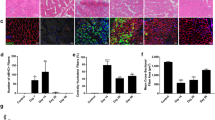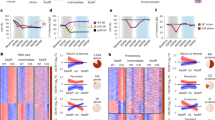Abstract
The adult heart lacks reserve cardiocytes and cannot regenerate. Therefore, a large acute myocardial infarction often develops into congestive heart failure. To attempt to prevent this progression, we transplanted skeletal myoblasts into cryoinfarcted myocardium of the same rabbits (autologous transfer), monitored cardiac function in vivo for two to six weeks and examined serial sections of the hearts by light and electron microscopy. Islands of different sizes comprising elongated, striated cells that retained characteristics of both skeletal and cardiac cells were found in the cryoinfarct. In rabbits in which myoblasts were incorporated, myocardial performance was improved. The ability to regeneratefunctioning muscle after autologous myoblast transplantation could have a important effect on patients after acute myocardial infarction.
This is a preview of subscription content, access via your institution
Access options
Subscribe to this journal
Receive 12 print issues and online access
$209.00 per year
only $17.42 per issue
Buy this article
- Purchase on Springer Link
- Instant access to full article PDF
Prices may be subject to local taxes which are calculated during checkout
Similar content being viewed by others

References
Taylor, D.A. et al. Delivery of Primary Autologous Skeletal Myoblasts into Rabbit Heart by Coronary Infusion: A Potential Approach to Myocardial Repair. Proc. Assoc. Am. Physicians 109, 245–253 (1997).
Robinson, S.W. et al. Arterial delivery of genetically labelled skeletal myoblasts to the murine heart: long-term survival and phenotypic modification of implanted myoblasts. Cell Transplant. 5, 77–91 (1996).
Chiu, R.C.-J., Zibaitis, A. & Kao, R.L. Cellular cardiomyoplasty: myocardial regeneration with satellite cell implantation. Ann. Thorac. Surg. 60, 12–18 (1995).
Marelli, D., Desrosiers, C., El-Alfy, M., Kao, R.L. & Chiu, R.C.-J. Cell transplantation for myocardial repair: an experimental approach. Cell Transpant. 1, 383–390 (1992).
Soonpaa, M.H., Koh, C.Y., Klug, M.G. & Field, L.G. Formation of nascent intercalated disks between grafted cardiomyocytes and host myocardium. Science 264, 98–101 (1994).
Koh, G.Y., Soonpaa, M.H., Klug, M.G. & Field, L.J. Long-term survival of AT-1 cardiomyocyte grafts in syngeneic myocardium. Am. J. Physiol. 264 (Heart Circ Physiol 33), H1727–H1733 (1993).
Klung, M., Soonpaa, M., Koh, G. & Field, L. Genetically selected cardiomyocytes from differentiating embronic stem cells form stable intracardiac grafts. J. Clin. Invest. 98, 216–224 (1996).
Bischoff, R. Regeneration of single skeletal muscle fibers in vitro. Anat. Rec. 182, 215–236 (1975).
Watt, D.J., Karasinski, J., Moss, J. & England, M.A. Migration of muscle cells. Nature 368, 406–408 (1994).
Stockdale, F.E., Hager, E.J., Fernyak, S.E. & DiMario, J.X. in Myoblast Transfer Therapy (eds. Criggs, R.C. & Karparti, G.) 7–11 (Plenum Press, New York, 1990).
Drake-Holland, A.J., Belcher, P., Hynd, J. & Noble, M.I.M. Infarct size in rabbits: a modified method illustrated by the effects of propranolol and trimetazidine. Basic Res. Cardiol. 88, 250–258 (1993).
Gill, W., Da Costa, J. & Fraser, J. The control and predictability of a cryolesion. Cryobiol. 6, 347–353 (1970).
Gill, W. & Long, W.B. The completeness of cellular destruction within a cryolesion. Brit. J. Surg. 58, 870 (1971).
Glower, D.D. et al. Linearity of the Frank-Starling relationship in the intact heart: the concept of preload recruitable stroke work. Circulation 1985, 994–1009 (1985).
Silvestry, S.C. et al. The in vivo quantification of myocardial performance in rabbits: a model for evaluation of cardiac gene therapy. J. Mol. Cell. Cardiol. 28, 815–823 (1996).
Glantz, S.A. & Parmley, W.W. Factors which affect the diastolic pressure-volume curve. Circ. Res. 42, 171–180 (1978).
Magid, N.M. et al. Left ventricular diastolic and systolic performance during chronic aortic regurgitation. Am. J. Physiol. 263, H226–H233 (1992).
Guerette, B., Asselin, I., Skuk, D., Entman, M. & Tremblay, J.P. Control of inflammatory damage by anti-LFA-1: increase success of myoblast transplantation. Cell Transpl. 6, 101–107 (1997).
Jarvis, J.C., Sutherland, H., Kwende, M.M.N., Mayne, C.N. & Salmons, S. in Cardiac Bioassist (eds. Carpentier, A., Chachques, J.C. & Grandjean, P.) 269–272 (Futura Publishing, Armonk, NY, 1997).
Author information
Authors and Affiliations
Rights and permissions
About this article
Cite this article
Taylor, D., Atkins, B., Hungspreugs, P. et al. Regenerating functional myocardium: Improved performance after skeletal myoblast transplantation. Nat Med 4, 929–933 (1998). https://doi.org/10.1038/nm0898-929
Received:
Accepted:
Issue Date:
DOI: https://doi.org/10.1038/nm0898-929
This article is cited by
-
Effect of once versus twice intracoronary injection of allogeneic-derived mesenchymal stromal cells after acute myocardial infarction: BOOSTER-TAHA7 randomized clinical trial
Stem Cell Research & Therapy (2023)
-
Engineering of MSCs sheet for the prevention of myocardial ischemia and for left ventricle remodeling
Stem Cell Research & Therapy (2023)
-
Remodeled eX vivo muscle engineered tissue improves heart function after chronic myocardial ischemia
Scientific Reports (2023)
-
Transplantation of mesenchymal stem cells for prevention of acute myocardial infarction induced heart failure: study protocol of a phase III randomized clinical trial (Prevent-TAHA8)
Trials (2022)
-
Single vs. double intracoronary injection of mesenchymal stromal cell after acute myocardial infarction: the study protocol from a randomized clinical trial: BOOSTER-TAHA7 trial
Trials (2022)


